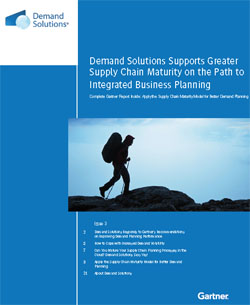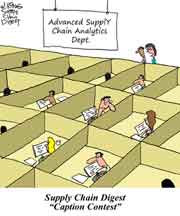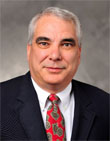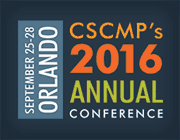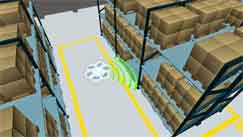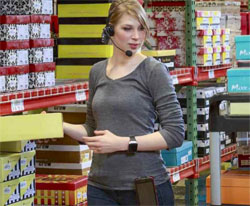 |
October 6, 2016 - Supply Chain Flagship Newsletter |
 |
| FEATURED SPONSOR: APEX SUPPLY CHAIN TECHNOLOGIES |
|||
 |
|||
| Download the Complimentary White Paper To Help Reduce Waste, Improve Productivity and Thrive in Real-Time Retail |
|||
 |
|
||||||||||||||||||||||||||||||||||||||||||||||||||||||||||||||||||||||||||||||||||||||||||
Also, Mary Long, VP of supply chain at Domino's, will be the CSCMP board chair for the 2016-17 term. For many years very active in CSCMP, Long stressed that a meaningful career in supply chain is really based on service to your team, your company and your professional discipline, and that CSCMP offers numerous ways to contribute to the profession, as she has done in many capacities. As a side note, this year, I believe for the first time, it was required that to be a speaker or panelist that you had to be a CSCMP member. Non-members submitting proposed sessions late last year, for example, were told they and/or their co-presenters would have to join up if they wanted to be considered. A bit of hardball, for sure - we will have to see how this plays out over time. The efforts have led to $200 million in lower supply chain costs over the past two years, If Sustainability increases supply chain costs, Bhargava said, the business unit leaders will simply lose interest, worried about seeing their margins erode. Also, 90% of Dell's aggressive Sustainability goals are on track for achievement.
And that before two new Amazon DCs come on-line in the area, requiring another 3000 or so DC workers. DeNunzio says he has recently seen DC job postings topping $18 per hour in the area. DHL's Adrian Kumar sees a bright future for smart glasses and augmented reality for order picking in the DC, and the company has a number of pilots with clients going on across the globe, including in Columbus (e.g. pick paths visualized, virtual putwalls created through the glasses without physical lights). This is coming, I believe.
Did you go to CSCMP 2016? If not, why not? If yes, what are your thoughts? Any reaction to the educational session summaries this week? Let us know your thoughts at the Feedback button below.
|
|||||||||||||||||||||||||||||||||||||||||||||||||||||||||||||||||||||||||||||||||||||||||||
|
|||||||||||||||||||||||||||||||||||||||||||||||||||||||||||||||||||||||||||||||||||||||||||
|
|||||||||||||||||||||||||||||||||||||||||||||||||||||||||||||||||||||||||||||||||||||||||||
|
|
|
YOUR FEEDBACK
We're just featuring this week an interesting email exchange relative to a point made by Thomas Moore of Warehouse Optimization on a recent Supply Chain Newsmakers video, which argued that shippers can have much to gain through a better understanding - load by load - of their carriers' true weight limits.
David Schneider of David K. Schneider & Company took some exception to this notion, as you can see from his email below, and then Moore's interesting response back.
Both are friends of SCDigest - and we would be happy with one more ripost from Schneider!
Feedback on Knowing Carriers' True Weight Limits
![]()
The video segment brought this phrase to my mind: "Your performance will vary."
I’m not calling bull s--t on what the fellows from Warehouse Optimizers talked about, but there are practical factors that I think could be wrongly defined as "tribal" knowledge.
Fuel weighs something: Over the road diesel weighs about 7.1 pounds per gallon. So every 100 gallons of fuel on board adds 710 pounds to the GVW of the rig. Many drivers know this, and will wait to fuel until after they have scaled their load if they know that they are close to the 80K limit. Is this "tribal knowledge?" No, as it is something that is taught in many of the driver schools. While a local delivery rig may hold only 45 gallons of fuel in each side tank, it is not unusual to see rigs with 130 gallons on each side, sometimes more.
Driver and driver's gear weigh something: The driver's weight is obvious, but people tend to forget that drivers often live in their tractors - and the belongings can weigh in.
Accessories on the truck: Snow Chains, HazMat kit, skirts, Aero-tails, APU units, again, these all add weight.
Trucking companies do not have high consistency across the fleet. They may specify the same basic model, but the accessories will change the weight of the tractor and the trailer from unit to unit. Metal roof trailer or translucent plastic roof? Hardwood trailer floor or a composite material? E track or logistics track (they are different).
What is getting identified as "tribal: is really a reflection of the variability of vehicle weights based - the complexity of the fleet. If you ask a trucking dispatcher, a driver, or an executive what a truck weighs, they are going to give you the "average" because they recognize that the weight of a truck depends on many factors that are out of control.
David K. Schneider
David K Schneider & Company, LLC
Response from Moore:
This is great! It typifies the response that we often see. The Tribe has a set of assumptions that generate "safe" answers. Here is a very concrete example from companies that shall remain nameless - the total weight that refrigerated trucks can carry:
Company 1 45,000
Company 2 44,000
Company 3 43,500
Company 4 42,000
They all use about the same carrier base!
Data is the key. We took Swift's and JB Hunt's fleets and weighed the various combinations of tractors and trailer a few years back. Yes there was variation and yes we could not take the lightest tractor and the lightest trailer as our standard - but we developed a standard that 95% of the fleet could easily meet.
In another example, it turned out that JBH intermodal had a habit of sending sleepers into the client to drive the 25 miles to the ramp -the client asked them to stop doing that so they could get the extra weight on the loads. Will Cotten's example in the video is real. He ran many loads for, what turns out to be, one of our current clients!
To put this all in perspective, 8 years ago we got about 880,000 records of 5 axle trucks weighed by the DOT. Of those that were clearly weighted out (more than 69K gross) a very large number(81%) had >3000 gross weight available.
Thomas Moore![]()
SUPPLY CHAIN TRIVIA ANSWER
Q: In the late 1980s and early 1990s, what supply chain initiative was championed by Roger Milliken of Milliken & Company, among others, as a life raft for the US textile and apparel industries?
A: Quick Response, which had mixed results at best.
| © SupplyChainDigest™ 2003-2016. All Rights Reserved. SupplyChainDigest PO Box 714 Springboro, Ohio 45066 |
POWERED BY: XDIMENSION
|

